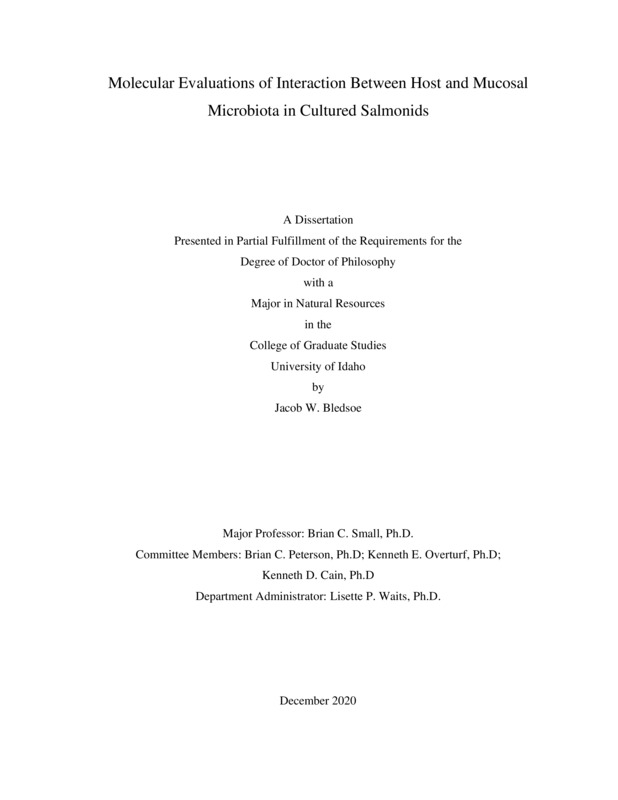Molecular Evaluations of Interaction Between Host and Mucosal Microbiota in Culture Salmonids
Bledsoe, Jacob William. (2020-12). Molecular Evaluations of Interaction Between Host and Mucosal Microbiota in Culture Salmonids. Theses and Dissertations Collection, University of Idaho Library Digital Collections. https://www.lib.uidaho.edu/digital/etd/items/bledsoe_idaho_0089e_11988.html
- Title:
- Molecular Evaluations of Interaction Between Host and Mucosal Microbiota in Culture Salmonids
- Author:
- Bledsoe, Jacob William
- Date:
- 2020-12
- Keywords:
- Flavobacterium psychrophilum host-microbiota interaction infectious hematopoietic necrosis virus Mucosal microbiota Salmonids Transcriptomics
- Program:
- Natural Resources
- Subject Category:
- Aquatic sciences; Animal sciences; Molecular biology
- Abstract:
-
The biggest hurdles to the environmentally and economically sustainable aquaculture production of finfish involve issues related to disease and nutrition. Mucosal tissues and their associated commensal microbiota lie at the interface between animal and environment and are known to play an integral role in both nutrition and immunity, yet their interactions have been poorly studied in fish. As such, the aim of the work presented here was to utilize high- throughput molecular methods to provide a comprehensive and resolute characterization of salmonid mucosal tissues and their bacterial microbiota in response to multiple sources of variation, which are commonly encountered in an aquaculture setting (i.e. host genetics, mucosal tissue, developmental stage, diet, viral and bacterial disease, and stage of infection). In the first study, it was shown that Atlantic salmon differentially regulated their gut, gill, and skin microbiota, irrelevant of dietary functional feed treatments, and differences in key host regulatory immune genes across tissue showed high correlation with bacterial microbiota communities (Procrustes, correlation = 0.818, p ≤ 0.001). The functional capacity of microbiota showed adaptive differences in bacterial metabolism by tissues with increased fermentation and nutrient metabolism pathways detected in the gut and denitrification pathways being more abundant in microbiota of the gill, the primary site of excretion of endogenous ammonia in fish. Bacterial gene ontology was correlated with bacterial phylogenetic composition, but pathway level comparisons showed many bacterial pathways to be highly conserved across phylogeny. A second study was conducted to compare intestinal transcription and gut microbiota at critical early life stages (40 and 65 days post hatch) in a commercial strain of rainbow trout and a strain selectively bred for growth performance on a sustainable all plant-protein diet. Selected trout showed superior growth at early life stages and hundreds of genes and gut bacteria were identified as biomarkers of the select strain. As the first study to conduct high-throughput differential transcript usage (DTU) analysis on RNA sequencing data in an aquaculture species, results also highlighted some 74 intestinal genes that were expressed by different mRNA isoforms, depending on trout genetics and developmental stage. As in the first research chapter, the dynamics of gut microbiota communities across trout strains and ontogeny showed high congruency to that of transcriptome-wide intestinal gene expression profiles (Procrustes m2 = 0.19, correlation =0.9, p ≤ 0.001). In the final study, naïve individuals from these same strains of rainbow trout were challenged with virulent infectious hematopoietic necrosis virus (IHNV) or Flavobacterium psychrophilum, (Fp) viral and bacterial pathogens that cause severe epizootics in salmonids, often with high mortality rates. Samples were collected at early (4-5 days post challenge [dpc]) and late (20-21 dpc) timepoints to track the dynamics of serum immune response, intestinal transcription, and gut microbial ecology. The select stain showed superior resistance to the bacterial challenge compared to the commercial strain (70.4% vs 94.8% mortality), but not the viral challenge (51% vs. 52%). Serum lysozyme and alternative complement activity were generally higher in the select strain. Intestinal transcription data indicated that DTU is an advantageous molecular mechanism utilized by rainbow trout to cope with both viral and bacterial infections, as many of the isoforms involved in DTU were related to crucial functions involved in effective disease response. Gene expression data showed rather classical responses to infection, with some clear differences between trout genetics as well. The IHNV challenge led to an influx of opportunistic bacteria not traditionally observed in the fish gut, though the community was slightly stabilized by the late recovery stage of disease. In the Fp challenges, the pathogen was found to take over the gut bacterial communities and showed dominant abundance in the gut during early infections, despite not being thought of as a target tissue of the bacterium. However, by the late recovery stage, beneficial commensal bacteria began recolonizing the gut of challenged select strain survivors, as the communities began to more closely resemble uninfected controls. Together, these studies provide many novel data on host and microbiota responses in cultured salmonids. The insights presented here have valuable implications on continued efforts to improve mucosal vaccines, selective breeding of finfish, fish health management, pre- and probiotic development, as well as our basic understanding of host-microbiota- environment interactions, in general.
- Description:
- doctoral, Ph.D., Natural Resources -- University of Idaho - College of Graduate Studies, 2020-12
- Major Professor:
- Small, Brian C
- Committee:
- Peterson, Brian C; Overturf, Kenneth E; Cain, Kenneth D
- Defense Date:
- 2020-12
- Identifier:
- Bledsoe_idaho_0089E_11988
- Type:
- Text
- Format Original:
- Format:
- application/pdf
- Rights:
- In Copyright - Educational Use Permitted. For more information, please contact University of Idaho Library Special Collections and Archives Department at libspec@uidaho.edu.
- Standardized Rights:
- http://rightsstatements.org/vocab/InC-EDU/1.0/

